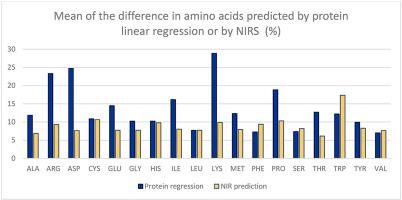Animal Nutrition ( IF 6.1 ) Pub Date : 2021-09-27 , DOI: 10.1016/j.aninu.2021.07.004 Samantha J Noel 1 , Henry J Høgh Jørgensen 1 , Knud E Bach Knudsen 1

|
Knowledge of the amounts and digestibility of amino acids in pig feedstuffs is essential for calculating the appropriate inclusion level in a complete diet. Wet chemical analysis and in vivo digestibility trials are time-consuming and costly and cannot be used for routine assessment. Near-infrared spectroscopy (NIRS) offers a rapid, cost effective and environmentally friendly method for evaluating feedstuffs. Calibrations models were developed using NIRS to predict the content of crude protein and 18 amino acids from a wide range of feedstuffs used in pig production (n = 607). The samples ranged from single feed ingredients (containing amino acids from 0.3 to 129.8 g/kg of dry matter) to feed mixtures (containing amino acids from 1.2 to 53.2 g/kg of dry matter). The predictive ability of the calibrations was tested with an independent dataset (n = 150) and with cross-validation. Furthermore, we compare these calibrations with calibrations developed on more narrowly defined groups of samples and with predictions from regression analysis of crude protein. The models were able to predict the concentrations of crude protein and 18 amino acids with good levels of precision and high coefficients of determination for calibration (RSQ CAL) from 0.91 to 0.99 and validation (RSQVAL) from 0.87 to 0.97. Calibration models were able to predict all amino acids except tryptophan and valine with greater accuracy than those from protein regression. We also developed calibration models to predict the apparent ileal and total tract digestibility of protein and amino acids. With the exception of tryptophan, RSQ values (>0.7) and standard error of cross validation (SECV) values (<5%) were obtained for the digestibility of most of the amino acids. In conclusion, NIRS can be used to predict crude protein and amino acid concentrations from a wide range of single ingredients and feed mixtures used for pig diets without separate models for each feedstuff. The digestibility of protein and amino acids can be predicted with an acceptable accuracy to be useful in formulating pig diets.
中文翻译:

使用近红外光谱预测猪的个体饲料和混合饲料中的蛋白质和氨基酸组成和消化率
了解猪饲料中氨基酸的含量和消化率对于计算完整日粮中适当的添加水平至关重要。湿化学分析和体内消化率试验既费时又费钱,不能用于常规评估。近红外光谱 (NIRS) 为评估饲料提供了一种快速、经济且环保的方法。校准模型是使用 NIRS 开发的,用于预测生猪生产中使用的各种饲料中的粗蛋白和 18 种氨基酸的含量 ( n = 607)。样品范围从单一饲料成分(含有 0.3 至 129.8 克/千克干物质的氨基酸)到饲料混合物(含有 1.2 至 53.2 克/千克干物质的氨基酸)。校准的预测能力通过独立数据集 ( n = 150) 和交叉验证进行了测试。此外,我们将这些校准与在更窄定义的样品组上开发的校准以及粗蛋白回归分析的预测进行比较。该模型能够预测粗蛋白和 18 种氨基酸的浓度,具有良好的精确度和高确定系数(RSQ CAL),从 0.91 到 0.99 和验证(RSQ VAL)) 从 0.87 到 0.97。校准模型能够比蛋白质回归模型更准确地预测除色氨酸和缬氨酸之外的所有氨基酸。我们还开发了校准模型来预测蛋白质和氨基酸的表观回肠和总消化道消化率。除色氨酸外,大多数氨基酸的消化率均获得了 RSQ 值 (>0.7) 和交叉验证标准误 (SECV) 值 (<5%)。总之,NIRS 可用于预测来自各种单一成分和用于猪日粮的饲料混合物的粗蛋白和氨基酸浓度,而无需为每种饲料建立单独的模型。可以以可接受的准确度预测蛋白质和氨基酸的消化率,以用于配制猪日粮。











































 京公网安备 11010802027423号
京公网安备 11010802027423号